I have several barlows in my possession, some came part of larger purchases (a Celestron 2x and a Skywatcher 2x), some where bought when I wanted more than 2x at good quality (High Point Scientific 2.5x, TeleVue 3x, TeleVue Powermate 5x) and some because I was just curious what you could get for cheap (no-name 3x ED, 5x Datyson). Having tried them all, I ended up only using 2-3 of them and I guess it would be good to share my experience with others especially so that they can see what an inexpensive barlow can get them, especially compared to the standard all barlows are usually compared to: the TeleVues Barlow or Powermate.
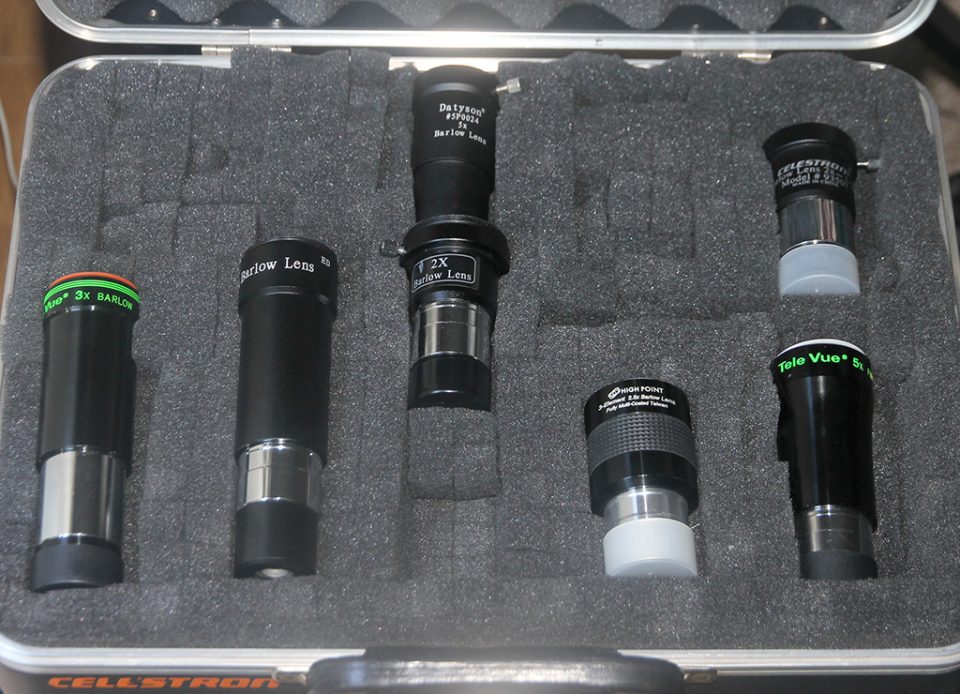
From left to right: TeleVue 3x, 3x ED, Datyson 5x (top), SkyWatcher 2x (bottom), High Point 2.5x, Celestron 2x (top), TeleVue Powermate 5x (bottom)
The contenders:
| Brand/Model | Optical design | Price | Multiplier (f) with DSLR/80ED |
|---|---|---|---|
| SkyWatcher 2x* | 2-element achromat | £29 | 2.89x (f/21.7) |
| Celestron #93507 2x* | 2-element achromat | £23 / $43 | 2.9x (f/21.8) |
| Hight Point Scientific 2.5x | 3-element APO | $50 | 3.14x (f/23.5) |
| No-name 3x ED | 2-element ED achromat | £20 / $20 | 3.91x (f/29.3) |
| TeleVue 3x | 2-element achromat | £108 / $120 | 4.26x (f/32) |
| Datyson 5x | 2-element achromat | £10 / $12 | 5.05x (f/37.9) |
| TeleVue Powermate 5x | 4 elements in 2 groups | £202 / $208 | 6.66x (f/49.9) |
*I have found the barlow styles I bought as SkyWatcher & Celestron, both under either brand name – which makes sense, as they are made by the same manufacturer (Synta). While you could find these two styles easily in the past, they seem to be abandoning the style without the T-thread on top (Celestron #93507), so you will most likely find both “Celestron” and “SkyWatcher” 2x barlows currently sold looking exactly like what is tested here as “SkyWatcher 2x” (and hopefully with identical quality).
Barlows and some PowerMates increase the magnification as you move the sensor farther away from the lens. In fact, TeleVue provides graphs that show you the exact magnification you will get as a function of the distance, with the nominal (3x, 5x etc) achieved when the sensor is exactly level with the top of the barlow. Since I used the most common way of attaching a DSLR, which is via a 1.25″ to t-adapter and a EOS T-ring, the barlows are at almost 60mm distance, so I list the actual magnification achieved on the table above (along with the f/ratio that the f/7.5 80ED scope is pushed to.
One take-away from the specs above, is that “on paper” the TeleVue 3x is a very simple 2-element design that does not claim to be APO, Semi-APO etc, and yet people have been saying that it feels “invisible”, i.e. it does not add any noticeable aberrations to the image (spoiler: they are mostly correct). Also, the Powermate is quite a different design and it is not really called “barlow”, although for the purposes of this post I will use the term “barlow” to refer to all barlows and the Powermate.
Daytime test
Most barlow reviews I’ve seen are subjective reports. I like results that are as objective as possible and reproducible so as usual for this blog I will use a DSLR camera (a Canon 550D, plus a full spectrum Canon 600D with a UV/IR filter) to record results. Comparing barlows of different magnifications might not seem easy at first, however if you have enough light to accommodate your strongest barlows, you can certainly get a good idea of the clarity, contrast and CA (chromatic aberration) of each. The first and what I’d consider the most telling test is the daylight test. The advantage of testing in daylight is that you don’t have differences in “seeing”, there is enough light to test the 5x on the 80ED and due to the fact that there is a lot of light coming through, the effect of bad coatings or reflective surfaces is intensified, with visible drop in contrast and even visible glow for some barlows.
My target for this test (which uses my SkyWatcher 80ED) is a tree branch over 100m away, in front of a clear summer sky:
The vignetting is of course due to the 1.25″ adapter. I would prefer an immovable target, but no appropriate ones were available from my back yard, so I just had to make sure I didn’t shoot when I could sense some wind (and in general get many shots of each lens). I am displaying the results below, with the full frame (click to enlarge) and a 100% crop of the detail I was focusing on for each barlow. As the magnification increased, I did have to use fast exposures and high ISO which leads to more noise/granulation, clearly visible on the crop, so you have to disregard it and focus on the detail that is visible instead.
Skywatcher 2x:


Celestron 2x:


High Point 2.5x:
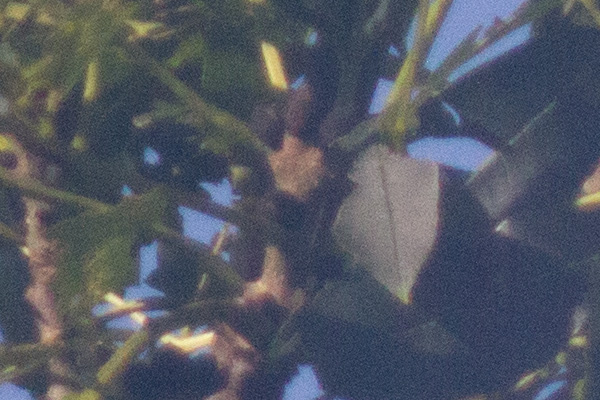

ED 3x:


TeleVue 3x:


Datyson 5x:


TeleVue Powermate 5x:
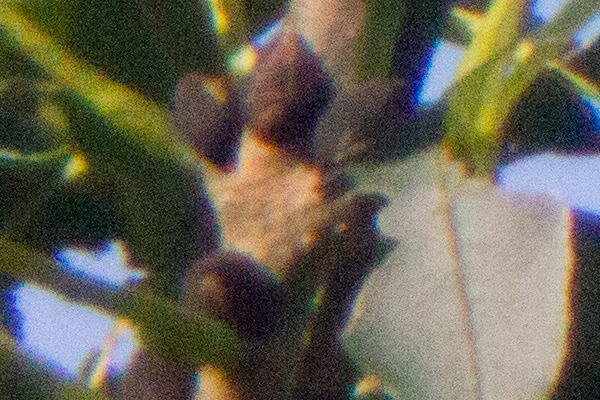

This first test does with the experience both visual and photographic that I’ve had with the barlows. The SkyWatcher and Celestron are similar, but not identical, with the Skywatcher usually having a slight edge. Both are quite usable, which is a good thing as many people have them as part of their telescope package. The High-Point is quite disappointing, with 3-elements it has more CA than the SkyWatcher/Celestron 2x units, so it is definitely not “APO” and it gives lower contrast views (day and night). The biggest surprise is the no-name 3x ED barlow which actually seems like an improvement over the basic Skywatcher/Celestron, while it costs even less at many places (ebay, amazon etc). It is still not as good as the TeleVue 3x, which, despite its simple 2-element design, does indeed seem to be mostly “invisible” – clarity stays the same, you just get magnification. It is quite hard to compare it to the 5x Powermate, as the 80ED working at almost f/50 required a very high ISO (with a short exposure to avoid shaking at such a focal length). I would need to compare a 2x TeleVue barlow to a 2x TeleVue Powermate to really discern whether there is a quality advantage over going to the more expensive Powermate. Lastly, the “Datyson 5x” photo is not a trick, it really is absolute garbage quality. You really are better off taking a photo without it and then enlarging it 5x yourself – the pixels will be big, but at least they will be clear!
The Sun
Next, we turn to the sun, again with the Full Spectrum 600D with a UV/IR filter through a Baader Astrosolar photo film. Usually we process these pictures in BW or fake yellow, but the original color is left so that the comparison does not go through needless processing steps – only the brightness was equalized. The Baader filter gives a white color normally, but the red-sensitive modified camera gives a pinkish hue.
Skywatcher 2x:
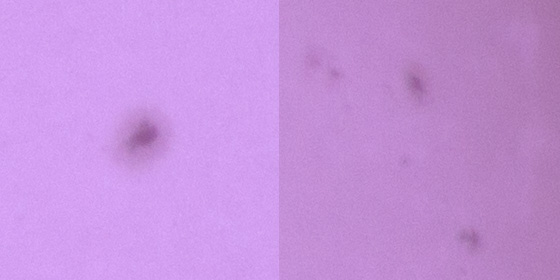
Celestron 2x:
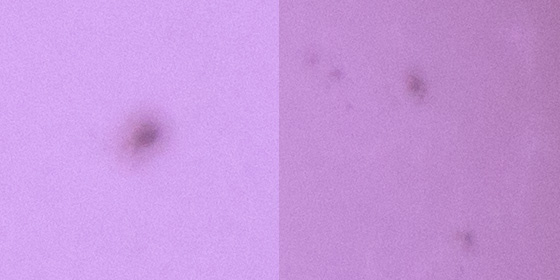
High Point 2.5x:

ED 3x:

TeleVue 3x:

Datyson 5x:

TeleVue Powermate 5x:
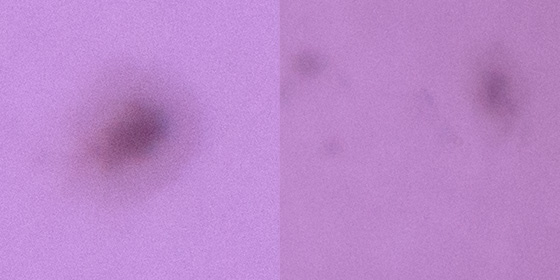
Once more we see similar results to the previous test: Some difference is visible between the Skywatcher and the Celestron favoring the former, the High Point does badly, while the no-name ED does well, and the TeleVue units come on top, with actually some extra detail visible on the PowerMate 5x compared to the 3x Barlow this time around.
I will probably repeat the test at a later time, especially between the two TeleVue units, taking a full solar video for processing to see what results stacking and sharpening can give us – although, again, one being 3x and the other 5x introduces too many variables for a comparison.
Printed Pattern Test
Next, I though I’d point the telescope to a printed pattern at 10+ meters away. The black on white pattern is good at showing CA problems that show up in high contrast situations.
Yes, I know, you expected the next test to be night sky, however I don’t really have a good target (i.e. Solar System) visible this time of year from my back yard (even the Moon is too low and has a very small window between trees). Maybe a future update.
In any case, let’s have a look at some crops (they are displayed at 50% crop, but clicking will give you the 100% crop image) :
Interestingly, in this test the TeleVue Powermate seems worse than the barlow, but it might be due to worse focusing (I used the 10x LiveView). The rest of the results hold pretty much the same.
Conclusions
I will probably revisit this test with one of my reflectors to exclude the ED80s (limited yet present) CA for a better comparison especially between the two TeleVue units (an f/5 newtonian will take the PowerMate to a more manageable f/25). But for now, this is how I see things:
- The Skywatcher 2x and Celestron 2x barlows are certainly not useless and can serve a beginner, especially if they came with your telescope. However, if you are looking to buy a new barlow, this review shows that they are not that great at a performance/price point of view. Also, we did see the SkyWatcher slightly out-performing the Celestron, but us the currently sold Celestron looks exactly like the SkyWatcher that I have, hopefully they are now the same quality.
- There is a widely circulated 3x ED barlow that is variously branded or sometimes comes no-name (like mine), and it is actually a great deal at an even lower price than the SkyWatcher/Celestron ones (albeit not the same magnification), but at a perceivably better quality. Great buy.
- The High Point Scientific 2.5x was so disappointing that I actually contacted High Point scientific and gave them a link to a draft of this test to ask them if they think there is something wrong with my barlow. Their response was also disappointing, they thought it did indeed look like my barlow was off, however they said they only had a 30 day warranty so they couldn’t help me. This means there is no way I can recommend this barlow. I mean, if you only find out later that your barlow is defective the manufacturer will not stand by it – and most people don’t have a bunch of barlows around to compare them and see things like that. In my case I just thought it was just not that great when I first bought it and bought a TeleVue after a while, but it was 2 years later when I did an actual comparative test and found out how bad it really is. Not many manufacturers would not offer to assist if they thought it was defective – and after having set up an entire comparative test no less! Well, I know of only one other manufacturer like that actually, Samsung, but that is a long story with a happier ending as the purchase was in the UK and the law covers manufacturing defects for 6 years no matter what the company tells you!
- You can’t go wrong with a TeleVue. Even the 3x with its simple 2-lens design performs as well as you’d expect from a good apochromatic – pretty much “invisible” in your optical train, not degrading the quality at all. Of course it doesn’t come cheap. And I am still not clear whether the PowerMate is better. It is often a moot point, as the barlows and PowerMates don’t overlap much after they stopped making a 2.5x barlow (it is now 2x & 3x 1.25″ barlows, 2.5x & 5x 1.25″ PowerMates and 2x & 4x 2″ PowerMates), but perhaps I’ll do some more testing.
- Lastly, even if you can find a good buy among the inexpensive Chinese stuff, you can also come across horrid quality as you can see from the Datyson 5x barlow. In fact, if you saw it at a store you would actually be impressed by the well machined metal construction, so you’d not suspect it would completely deteriorate your optical quality. So, no, you can’t just go around buying any cheap unknown stuff and expect it to even be worth the $10 you paid…


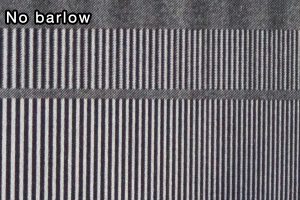



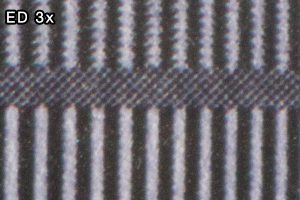

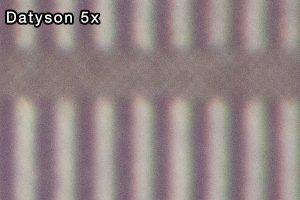

wow, I found this so interesting, I love this, thank you for sharing this post.
I have a photo that I would like to send you , I can make a 2x barlow into a 3x or 5x barlow for about 2 dollars , using the 2x barlow lens only
Hi. I assume you are talking about changing the lens spacing? I’ll send you an email if you want to send me a specific photo.